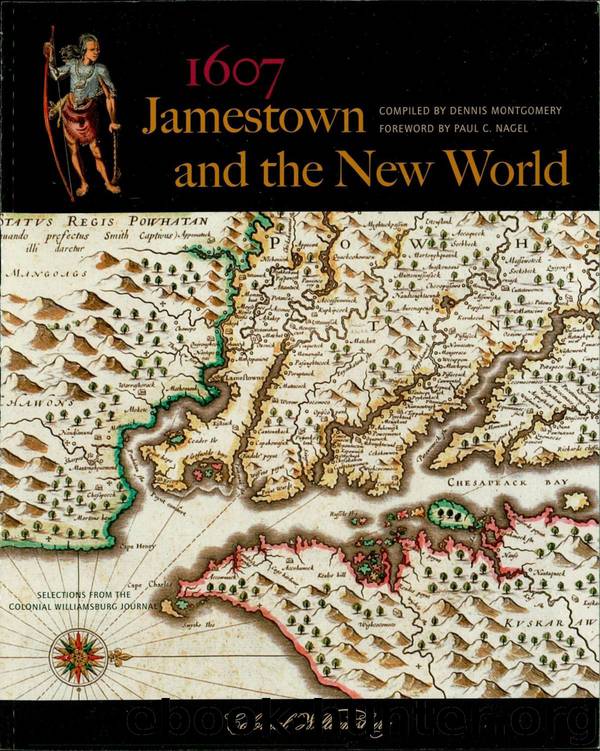'1607 by Unknown

Author:Unknown
Language: eng
Format: mobi, epub
ISBN: 9780742569003
Publisher: Rowman & Littlefield Publishers
Published: 2013-06-25T23:00:00+00:00
A modern view of Old Point Comfort and Fort Monroe.
A Dutch map shows the American prizes Spain and England hoped to hook.
But the Spanish king was thwarted. His fleet—which had cost ten million ducats, or about $375 million in today’s prices, to build and equip—was wiped out by the superior tactics of the English navy, commanded by Lord Howard and Sir Francis Drake, and by horrendous weather. Fifty-one Spanish ships and 20,000 Spaniards never made it home. It was Spain’s last attempt to bring England to heel. Within days, young John Clarke was listening to the great bells of old St. Paul’s Cathedral clanging a celebration of England’s victory. It was enough to make any boy run away to sea.
And, apparently, that was what Clarke did. Rotherhithe had always been a favorite place for old sea captains to retire to, and Clarke, perhaps inspired by their stories of daring and glory, soon packed his kit bag and followed in their sea-dog footsteps. Next time we catch sight of him is in 1609 in Malaga, Spain. He’d spent his days at sea and had become an experienced, well-traveled mariner, hailed as a pilot and well acquainted with coastlines and anchorages at home and abroad.
In early March 1611, Clarke sailed from London as pilot of a small squadron of merchant ships bound for Virginia. He had visited Virginia only once before, or so he said. One wonders how he got the job based on that rather slim experience. But there weren’t many English mariners experienced on the coasts of America, so Clarke’s voyage may not have been out of the ordinary.
There were three ships bound for the four-year-old colony. The cargo was 600 barrels of flour, fifty tons of gunpowder, and a consignment of arquebusses, seventeenth-century handguns. In addition 100 cows, 200 pigs, 100 goats, seventeen mares, and 300 soldiers—“men of war”—were crowded into the vessels. This was no up-market Caribbean cruise. Two and a half months later, after an uneventful Atlantic crossing, the expedition began off-loading the men of war at Fort Algernon on Point Comfort, just inside the Chesapeake Bay, and took the supplies upriver to Jamestown.
The English colonists were not the first to have settled these shores. Half a century before, a Spanish adventurer, Antonio Velasquez, had planted his country’s flag here, and the French, too, had raised forts along the Atlantic coastline in an imperial contest aimed at securing the biggest slice of the North American pie. But by 1600, the French had turned their colonial gaze toward Canada, and the new Spanish king, Philip III, had given up on the region. There were richer pickings further south in the Caribbean.
The arrival of the soldiers must have raised the spirits of the fledgling Virginia colony. Tensions had eased between the English and Spanish in the twenty years since the defeat of the Armada, but the peace was uneasy, and Jamestown was ever fearful of a Spanish attack. Which was not surprising. In her day, the English queen, Elizabeth,
Download
This site does not store any files on its server. We only index and link to content provided by other sites. Please contact the content providers to delete copyright contents if any and email us, we'll remove relevant links or contents immediately.
Housekeeping by Marilynne Robinson(4347)
Papillon (English) by Henri Charrière(4195)
The Poetry of Pablo Neruda by Pablo Neruda(4039)
World without end by Ken Follett(3428)
TCP IP by Todd Lammle(3134)
Fluent Forever: How to Learn Any Language Fast and Never Forget It by Gabriel Wyner(3028)
The Rape Of Nanking by Iris Chang(2774)
How Proust Can Change Your Life by Alain De Botton(2742)
The Alchemist by Paulo Coelho(2644)
The Partner by John Grisham(2347)
Two lives by Helen Naylor(2270)
Hitler by Ian Kershaw(2153)
Yerma by Federico García Lorca(2016)
Sophie's World by Jostein Gaarder(1968)
Smilla's Sense of Snow by Peter Hoeg(1907)
Merriam-Webster's Pocket Dictionary by Merriam-Webster(1882)
Twilight of Idols and Anti-Christ by Friedrich Nietzsche(1850)
Il cavaliere inesistente by Italo Calvino(1825)
Deep Writing by Eric Maisel(1784)
